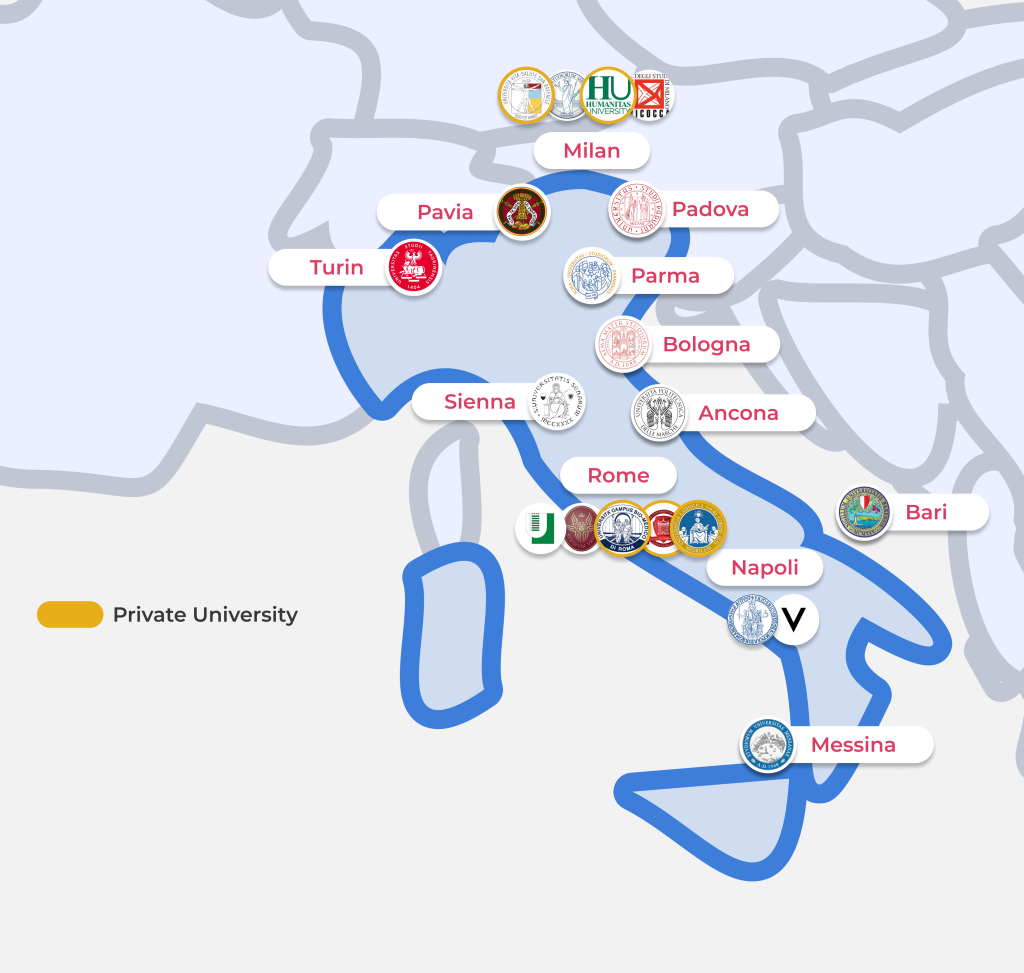
Ari Horesh University of Pavia, Italy
24th of December, 2024Hello everyone, Ari is here! Today, I wanted to discuss the rankings of medical schools in Italy. When I was a candidate and wanted to study medicine in Italy, I did tons of research to understand which university was ranked the highest. You will hear many things about ranking from different people, but when you ask them a few questions about how it works, they will probably have no idea. Different ranking systems check for a multitude of things at different times. In this article, I will not only give you the list of the best and highest-ranked medical schools in Italy – I will actually teach you which ranking systems are being used, how to read them, as well as how to use this information to choose the best university for yourself.
About choosing the correct university – this website is all about how to “enter med school”, so expect a lot more information. If you want to learn about how to choose a uni beyond the ranking, I expanded on this topic a lot in a different guide, so you can choose a medical school in Italy properly. For the sake of today’s topic, let’s see and discuss exactly what are the rankings’ numbers, their meaning, and which medical school is the best in Italy. Spoiler; there isn’t one in reality, only on paper, more on that soon. I am attaching the guide, a tutorial on the admission exam you must take to study medicine in Italy, and free study materials to get accepted into the most competitive Italian medical schools. I recommend reading them after this article. Let’s begin!

While ranking is important, it’s not the main thing to consider when choosing which medical school you want to go to! The ranking here are mainly based on research conducted and number of graduates.

Content Quick Navigation
Rankings System of Italian Medical Schools and How Do They Even Work
IMAT 2026 Most Comprehensive Course!
Hey! Ari is here. If you enjoy reading my articles, using my free study materials and communities for the IMAT, consider joining my IMAT 2026 Course! I took 3 years off my studies to work full time on this project – the most comprehensive, popular, and affordable IMAT course available today. Updated based on IMAT 2025’s questions.Common Global Ranking Systems
Let’s review some of the most common ranking systems that are used all over the world and in Italy, and if we should consider them more, or less than others.
- QS World University Ranking – This system is UK-based, a very popular ranking that you see on many websites, and mainly reviews the following metrics:
- Academic Reputation (based on survey)
- Employer Reputation (based on a survey of employers) – I don’t really like surveys when it comes to ranking because it is not very objective.
- Faculty/Student Ratio (teaching quality proxy) – this one is a great metric because the smaller the classes are, usually the higher the quality of the lessons is.
- Citation per Faculty (the research they conduct, like I mentioned earlier, we don’t really care about this topic much as medical students)
- International Faculty Ratio / Internation Student Ratio – a pretty cool metric to check the number of international student numbers and the international impact of that university in general.
- Times Higher Education (THE) World University Ranking – Is another popular UK-Based ranking, and it has five aspects:
- Teaching (the learning environment): surveys, staff/student ratio, etc., similar to the QS ranking that we saw before, just combined into one collective metric.
- Research (volume, income, and reputation): grants, surveys, and publications, of course – again, we don’t really care about it.
- Citations – same as above.
- International Outlook (international collaboration and impact) – a metric that tracks the effect graduates of that university had on medical research papers done outside italy.
- Industry Income – also called “Knowledge Transfer” in many different ranking systems. It’s pretty much how much the graduates earn after they go to that university.
Both systems are very common, so when you search for ranking online you will usually encounter one of them. Unfortunately, some big issues arise relying on them:
- They look at all of the university’s courses, not only medicine.
- Most don’t care about research in clinical medicine unless you want to do PhD and research using your medical diploma.
- Salaries after graduation are pretty much the same in many places in Italy for the first couple of years after you graduate.
- Surveys aren’t a good metric if you check all of the courses in a university at once, most would naturally be irrelevant.
What other systems are there, if not QS/THE?
- CENSIS (Centro Studi Investimenti Sociali) – is an Italian-based ranking system that checks the socio-economic benefits of different universities. They mainly check:
- Services such as scholarships, housing and campus facilities.
- Financial aids.
- Digital services (labs, classrooms).
- Exchange programs and connectivity.
- The problem with CENSIS is that they don’t separate the English and Italian courses
- Italian Ministry of Universities and Research (MIUR) – While not ranking the students, they do share some performance indicators that are very important to research and read about. They will allow you to understand the overall trend of specific courses at that university, giving us a really good insight into what’s going on with the students after they graduate, how many people transfer or repeat years, the scores of the students, and so much more! The MIUR summaries are probably the best way to see how the university is compared to others. While it’s not a traditional ranking system, it’s the best we have for international courses that teach medicine in English in Italy, a very specific niche. I use the MIUR analysis and reports to recommend my students specific universities; I combine it with feedback from past students who were accepted into different universities. You will see my own ranking down below.
Before we dive into the actual points and rankings, I would like to remind you (from the article I linked above) the proper way of choosing a university:
CENSIS Rankings for Medicine and Surgery Programs in Italy (2023/2024)
| University | CENSIS Score (out of 110) |
|---|---|
| University of Pavia | 109.5 |
| University of Milan-Bicocca | 100.5 |
| University of Bologna | 98.0 |
| University of Milan | 95.5 |
| University of Padua | 92.5 |
| University of Turin | 86.0 |
| University of Parma | 86.0 |
| Sapienza University of Rome | 84.5 |
| University of Messina | 84.0 |
| University of Rome Tor Vergata | 83.0 |
The latest and most reliable scores when it comes to the faculties.
EnterMedSchool Rankings for Medicine and Surgery Programs in Italy (2024/2025)
This is the ranking I made after reading data about the universities, surveying students who study specifically in the upper years of medical schools in Italy, and asking them to leave reviews and send me pictures about schools! I created it by grouping the universities into tiers.
- The Best Universities (4-5 stars): Pavia, Milano Bicocca, Bologna, Rome La Sapienza – this is mainly due to recent changes that were made in those schools, the level of education, the social and student life, scholarship opportunities, weather and air quality, student testimonials, level of professors and clinical opportunities in the hospitals. Pavia also gets 5 stars because I am there.
- Almost There (3-4 stars): Turin, Milano IMS, Parma, Tor Vergata. This is mainly because the university is good. But, the weather isn’t very good, it’s hard to get accepted, and you must commute 50 minutes (when it comes to Turin for example) to reach the medical campus from the city center.
- Not So Good (2-3 stars): Napoli Federico II, Ancona, Bari. This is because the universities have professors that teach in Italian, they don’t care much about students, you are pretty much on your own, and the city is dangerous.
- No Go Zone (1-2 Stars): Luigi Vanvitelli, Messina, Cagliari. This is because I couldn’t find a single student happy about these schools, stay away from them, I recommend retaking the IMAT if needed instead of getting accepted into one of them.




